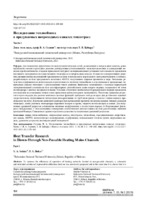| dc.contributor.author | Седнин, В. А. | |
| dc.contributor.author | Бубырь, Т. В. | |
| dc.coverage.spatial | Минск | ru |
| dc.date.accessioned | 2021-04-08T07:22:16Z | |
| dc.date.available | 2021-04-08T07:22:16Z | |
| dc.date.issued | 2021 | |
| dc.identifier.citation | Седнин, В. А. Исследование теплообмена в продуваемых непроходных каналах теплотрасс. Ч. 1 = Heat Transfer Research in Blown-Through Non-Passable Heating Mains Channels. P. 1 / В. А. Седнин, Т. В. Бубырь // Наука и техника. – 2021. – № 2. – С. 150-160. | ru |
| dc.identifier.uri | https://rep.bntu.by/handle/data/90018 | |
| dc.description.abstract | Для повышения эффективности эксплуатации тепловых сетей, размещенных в непроходных каналах, ранее предложено схемно-структурное решение регенеративно-утилизационного теплоиспользования и одновременно показана проблематичность создания приемлемой натурной экспериментальной установки или сложность проведения пассивного эксперимента на существующих теплотрассах в непроходных каналах. В качестве альтернативного решения для выполнения исследований предлагается создать и использовать виртуальную экспериментальную установку, разработанную на базе программного комплекса ANSYS, получившего широкое признание в мире. Начальные результаты верификации модели показали перспективность изучения теплообмена и аэродинамики в продуваемых непроходных каналах теплотрасс с использованием такого решения. Выполнено исследование с помощью виртуальной экспериментальной установки на базе шестифакторного ротатабельного плана второго порядка, содержащего 46 точек на гипершаре с шестью звездными точками. Показано отсутствие необходимости рандомизации порядка проведения и повторения исследования в точках плана проведения вычислительного эксперимента. Получены уравнения регрессии второго порядка для расчета комплекса целевых функций: требуемого напора воздуха для достижения заданной скорости потока, интенсивности теплоотдачи непосредственно от труб теплотрассы, а также от стенок канала к продуваемому воздуху. В качестве влияющих факторов при вычислениях приняты: геометрия каналов типовых размеров теплотрасс, длина участков, температуры наружного воздуха и грунта, скорость потока воздуха в канале. Для полученных уравнений регрессии установлены значимые коэффициенты и осуществлен переход от безразмерных факторов к натуральным. С использованием стандартных статистических методов оценок на базе рассчитанных значений критериев Фишера, Стьюдента и других определена адекватность полученных уравнений регрессии. | ru |
| dc.language.iso | ru | ru |
| dc.publisher | БНТУ | ru |
| dc.title | Исследование теплообмена в продуваемых непроходных каналах теплотрасс. Ч. 1 | ru |
| dc.title.alternative | Heat Transfer Research in Blown-Through Non-Passable Heating Mains Channels. P. 1 | ru |
| dc.type | Article | ru |
| dc.identifier.doi | 10.21122/2227-1031-2021-20-2-150-160 | |
| local.description.annotation | To increase the efficiency of operation of heating networks located in non-passable channels, a schematic
and structural solution of regenerative-utilization heat use was previously proposed and at the same time it is shown that it is difficult to create an acceptable full-scale experimental installation or the difficulty of conducting a passive experiment on existing heating mains in non-passable channels. As an alternative solution for performing research, it is proposed to create and use a virtual experimental setup developed on the basis of the ANSYS software package, which has received wide recognition in the world. The initial results of model verification showed that the study of heat transfer and aerodynamics in blownthrough non-passable heating mains using such a solution is promising. A study has been carried out using a virtual experimental setup based on a six-factor second-order rotatble plan containing 46 points on a hypersphere with six star points. It is shown that there is no need to randomize the order of conducting and repeating the study at the points of computational experiment plan. Second-order regression equations have obtained for calculating a complex of objective functions: the required air pressure to achieve a given flow rate, the intensity of heat transfer directly from the pipes of the heating main, as well as from the walls of the channel to the blown air. The geometry of the channels of typical standard sizes of heating mains, the length of the sections, the temperature of the outside air and soil, and the air flow rate in the channel have been taken as the influencing factors in the calculations. For the obtained regression equations, significant coefficients have been established and the transition from dimensionless to natural factors has been carried out. The adequacy of the obtained regression equations has been determined using standard statistical estimation methods based on the calculated values of the Fisher’s, Student’s and other criteria. | ru |

